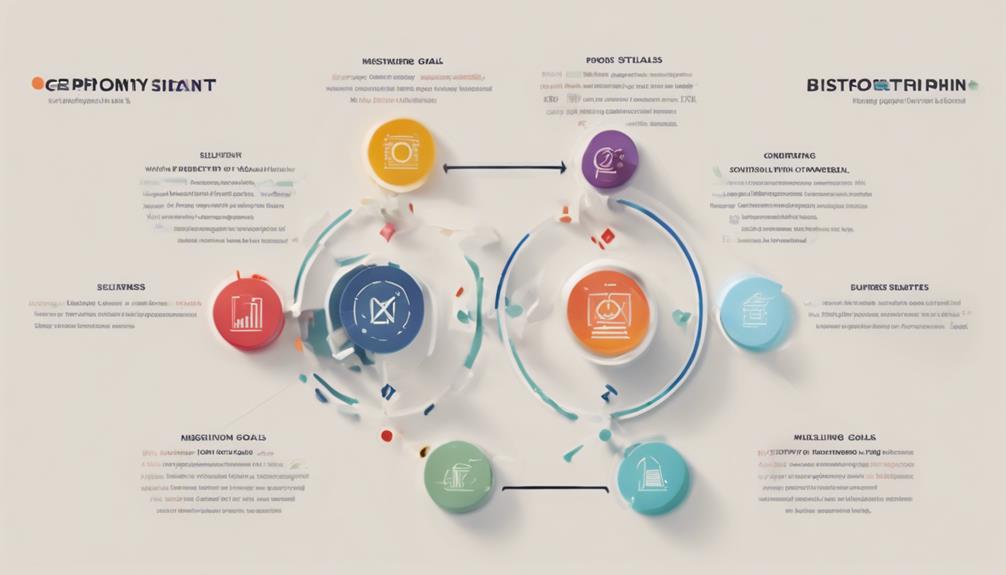As a beginner in the realm of business planning, did you know that approximately 50% of businesses fail within their first five years due to inadequate planning?
Understanding the essentials of crafting a robust business plan is crucial for your venture's success. From the foundational Executive Summary to the intricate details of financial projections and market research, each element plays a pivotal role in shaping the direction of your business.
So, are you ready to embark on a journey towards mastering the art of business plan writing?
Key Takeaways
- Craft a compelling executive summary summarizing key components.
- Describe your company succinctly and highlight its uniqueness.
- Clearly outline your products and services to showcase value.
- Include relevant appendix materials for additional information.
Executive Summary Tips
When crafting your executive summary, focus on presenting a concise and compelling overview of your business plan to captivate potential investors and set the stage for further exploration. The executive summary serves as a snapshot of your business, highlighting key details such as your business concept, target market, financial projections, and goals. This section is crucial as it acts as the gateway to the entire business plan, shaping the reader's interest from the outset. Investors often use the executive summary to gauge the viability of your business quickly, determining whether it's worth their time to delve deeper into the plan.
To ensure the success of your executive summary, make sure it's well-structured, informative, and engaging. Clearly articulate what sets your business apart, showcase your understanding of the market, and provide a glimpse into the potential financial returns. Remember, a well-crafted executive summary not only increases the chances of attracting investor interest but also paves the way for fruitful discussions about your business.
Company Description Essentials

At our company, our mission is clear: to revolutionize the way people approach [specific market] by providing innovative solutions that simplify everyday tasks and enhance overall efficiency. We are driven by a commitment to excellence, continuous improvement, and a passion for creating meaningful impact in the lives of our customers.
Our value proposition lies in our ability to blend cutting-edge technology with user-centric design, offering a seamless and intuitive experience that outshines our competitors. By prioritizing customer feedback and staying ahead of industry trends, we ensure that our products remain at the forefront of innovation, delivering unparalleled value to our target market.
In terms of our products and services, we offer a diverse range of solutions tailored to meet the unique needs of our customers. From [specific product/service] to [another product/service], each offering is designed to address common pain points and deliver tangible results. Our commitment to quality, reliability, and customer satisfaction sets us apart in a crowded marketplace, positioning us as a trusted partner for individuals and businesses alike.
Setting Clear Business Goals
What strategic approach can you take to effectively set clear business goals that provide direction, focus, and motivation for your team? Setting business goals that are SMART (Specific, Measurable, Achievable, Relevant, Time-bound) is crucial. To help you understand the importance of this approach, let's delve into a table that illustrates the benefits of setting clear business goals:
| Benefits of Clear Business Goals | Emotional Impact |
|---|---|
| Enhanced performance through clear direction | Motivation and focus |
| Efficient resource allocation and task prioritization | Sense of accomplishment |
| Improved tracking of KPIs for informed decision-making | Confidence and clarity |
Product and Service Descriptions

When describing your products and services in your business plan, ensure to clearly outline their unique features and benefits to attract potential customers effectively. Include pricing details, product specifications, and service offerings to provide a comprehensive understanding of what you offer.
Emphasize how your offerings fulfill specific customer needs, solve problems, and highlight any intellectual property or competitive advantages associated with your products/services.
Clear Descriptions Essential
To effectively convey the uniqueness and problem-solving capabilities of your offerings, crafting detailed product and service descriptions is essential for your business plan. When outlining your products and services, remember to:
- Highlight Your Value Proposition: Clearly articulate what sets your offerings apart from competitors.
- Define Target Customers: Describe the specific demographics or market segments your products/services aim to serve.
- Emphasize Benefits and Features: Detail the advantages customers will gain and the specific functionalities your offerings provide.
Benefits Highlighted Effectively
Crafting detailed and compelling product and service descriptions is a strategic imperative for highlighting the benefits effectively in your business plan. By clearly outlining the unique selling points and value proposition of your offerings, you enhance investor confidence and attract the interest of potential customers. Describing the benefits of your products and services sets you apart from competitors, helping you target specific market segments and increase funding opportunities. A well-crafted business plan with concise and engaging product and service descriptions can have a significant market impact, showcasing your business's innovation and potential to stakeholders.
| Key Benefits | Impact |
|---|---|
| Investor Confidence | Enhanced understanding |
| Value Proposition | Attraction to target markets |
| Increased Interest | Differentiation from competitors |
| Funding Opportunities | Potential for growth |
Market Research Strategies

Utilize a combination of surveys, interviews, and industry analysis to develop comprehensive market research strategies that inform your business planning and decision-making process. When diving into market research, consider the following:
- Customer Insights: Conduct surveys, interviews, and focus groups to gather valuable information about your target audience's preferences and behaviors.
- Competitor Analysis: Analyze industry reports and study competitor strategies to identify market gaps and opportunities for differentiation.
- Market Trends Exploration: Utilize online tools such as Google Trends, SEMrush, and SurveyMonkey to track market trends and consumer sentiment, enabling you to stay ahead of the curve.
Marketing and Sales Planning

When crafting your marketing and sales plan, you must focus on developing sales strategies that align with your business goals and target audience preferences.
Analyzing your target market thoroughly will enable you to tailor your promotional efforts effectively and drive sales growth.
Sales Strategies Overview
To develop a successful sales strategy within your marketing and sales plan, it's crucial to meticulously analyze your target audience and market trends for optimal results. When crafting your sales strategies, consider the following key aspects:
- Customer Segmentation: Divide your target market into specific groups based on demographics, behaviors, or needs to tailor your approach effectively.
- Pricing Strategies: Determine the best pricing model that aligns with your value proposition and target audience's willingness to pay.
- Product Positioning: Clearly define how your product stands out from competitors and communicate its unique value to your customers.
Target Market Analysis
To effectively drive sales and marketing strategies, begin by conducting a comprehensive analysis of your target market's size, preferences, and behaviors in the realm of business planning. Conduct market research to understand market trends, pricing strategies, and customer behavior within the competitive landscape.
Develop a customer segmentation strategy to tailor marketing efforts and product offerings to specific customer groups, ensuring your marketing plan effectively engages with your target market. Sales planning plays a crucial role in revenue growth, involving setting sales targets, creating sales strategies, and implementing tactics to drive business success.
Financial Analysis Techniques

Utilize key financial analysis techniques such as ratio analysis, trend analysis, and cash flow analysis to thoroughly evaluate a company's financial health and performance. When delving into financial analysis, consider the following:
- Ratio Analysis: Compare profitability ratios, liquidity ratios, and efficiency ratios against industry benchmarks to gauge performance and identify areas of strength or weakness.
- Trend Analysis: Examine financial data over time to uncover patterns, trends, and potential risks or opportunities that may impact the company's financial outlook.
- Cash Flow Analysis: Focus on monitoring the inflow and outflow of cash to ensure the business maintains proper liquidity levels and sustainable operations.
These techniques provide a comprehensive view of the business's financial standing, enabling you to make informed decisions and strategic plans. By understanding these methods and their implications, you can better navigate the complexities of financial analysis and position your company for long-term success.
Crafting Financial Projections

Crafting realistic financial projections requires a meticulous analysis of income, expenses, balance sheets, and cash flow statements over a five-year period to provide a comprehensive overview of the business's anticipated financial performance. In a business plan, these projections serve as a roadmap outlining the expected financial outcomes.
By detailing revenue sources and operating costs, you offer investors a clear picture of the business's revenue generation capabilities and its ability to control expenses. Investors heavily rely on these financial projections to assess the feasibility of your business, understand potential returns, and evaluate risks.
Ensuring the accuracy and reasonableness of your financial forecasts is crucial for gaining investor trust and support. Comprehensive financial projections not only demonstrate your financial acumen but also guide strategic decisions, helping you navigate challenges and capitalize on opportunities as your business evolves over time.
Appendix Inclusions

Including a comprehensive array of supporting documents in the business plan appendix enhances the credibility and completeness of your proposal for potential investors and stakeholders. When developing your business plan, consider including the following key elements in the appendix:
- Resumes of key employees: Highlight the expertise and experience of your management team to reassure investors of your business's competent leadership.
- Licenses, equipment leases, permits, and patents: Providing documentation for these aspects demonstrates that your business is legally compliant and has protected its intellectual property rights.
- Financial statements: Include receipts, bank statements, and contracts to showcase your financial stability and commitments, along with personal and business credit history for lenders and investors to assess your creditworthiness.
Moreover, if your business plan appendix is extensive, consider adding a table of contents for easy navigation. These inclusions will strengthen your business plan and instill confidence in potential investors and stakeholders.
Fundraising and Investment Considerations

Considering the various avenues available for fundraising and investment, it is essential to strategically evaluate each option to align with your business goals and financial needs effectively. Small business owners often kickstart their ventures using personal funds, showcasing dedication and belief in their ideas. Banks and financial institutions play a significant role, with 40% of small businesses seeking funding from these traditional sources. Crowdfunding has emerged as a popular choice, with a substantial $34 billion raised globally in 2019, highlighting the power of community support. For those aiming for substantial growth, venture capital presents a lucrative opportunity, as seen with the $136.5 billion invested in U.S. startups in 2020. Additionally, angel investors are crucial for early-stage businesses, providing $25 billion in funding in 2020. Evaluating these options carefully and aligning them with your business plan will be vital for securing the necessary resources to drive your entrepreneurial vision forward.
| Type of Funding | Statistics |
|---|---|
| Personal Funds | 29% of small business owners use personal funds to start their businesses |
| Banks/Financial Institutions | 40% of small businesses seek funding from banks or financial institutions |
| Crowdfunding | $34 billion raised globally in 2019 through crowdfunding platforms |
| Venture Capital | $136.5 billion invested in U.S. startups in 2020 |
| Angel Investors | $25 billion in funding provided to startups in 2020 |
Frequently Asked Questions
What Are the 5 Tips for Writing a Business Plan?
When writing a business plan, it's crucial to focus on:
- Financial projections,
- Market analysis,
- Competitive research,
- Target audience, and
- Product development.
Ensure your marketing strategy aligns with your operational plan and includes a SWOT analysis.
Start strong with an executive summary and back it up with a detailed sales forecast.
How Do I Write a Simple Business Plan?
To write a simple business plan, begin with an executive summary outlining your mission and product.
Conduct a market analysis, including a competitive analysis and target market identification.
Develop financial projections and a marketing strategy to showcase growth potential.
Detail your operations plan and include a SWOT analysis for strategic insights.
Tailor the plan to your audience, keeping it concise and goal-oriented for effective communication and business guidance.
What Are 7 Steps to a Perfectly Written Business Plan?
When crafting a business plan, start by conducting a thorough market analysis to understand your target audience's preferences.
Next, create detailed financial projections and assess the competitive landscape.
Clearly define your target audience and conduct a SWOT analysis.
Craft a concise executive summary, develop a robust marketing strategy, and outline an effective operations plan.
Remember to assess risks and identify potential funding sources for a comprehensive plan.
What Is the First Step in Writing a Business Plan?
When starting a business plan, your first step is to conduct thorough market research. This involves analyzing your target audience, industry trends, competitors, and identifying your unique value proposition.
It's essential to gather data to support your financial projections and develop a solid foundation for your business strategy. By understanding the market landscape, you can create a strong business plan that resonates with potential investors and stakeholders.
Conclusion
In conclusion, by following these 10 business plan writing tips for beginners, you can set yourself up for success.
Focus on creating a comprehensive plan with key components, realistic financial projections, and a strong marketing strategy.
Seek guidance from resources like Fundera, utilize free mentorship opportunities, and consider professional editing assistance.
Remember, clear and detailed planning is essential to attract investors and ensure the growth of your business.